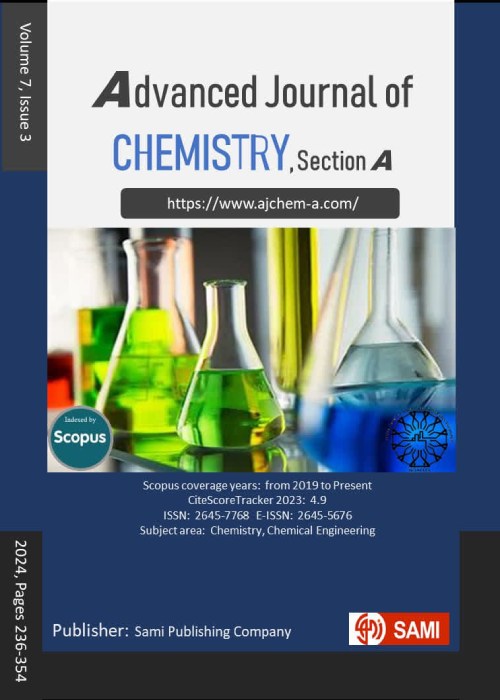فهرست مطالب
Advanced Journal of Chemistry, Section A
Volume:1 Issue: 2, Autumn 2018
- تاریخ انتشار: 1397/08/10
- تعداد عناوین: 6
-
Pages 66-78This work examined some physicochemical parameters of effluents from a Brewery Industry in Imo state. This company discharged effluents in non-compliance with the Nigerian National Regulations as confirmed from the Biochemical Oxygen Demand (BOD), Chemical Oxygen Demand (COD), Electrical Conductivity (EC), Nitrogen, and Turbidity results. The heavy metals have concentrations that were within WHO/FEPA limits. These confirmed results posed health risks to several rural communities which rely on the receiving water bodies as their primary source of domestic water. There is need for the intervention of appropriate regulatory agencies to ensure production of high quality treated final effluents. This scenario is typical of most industries in developing nations where enforcement of environmental regulations are deficient. To avoid pollution, regulatory authorities should closely monitor compliance by industries.Keywords: Effluent, Physicochemical, heavy metals, Biochemical Oxygen Demand (BOD), Chemical Oxygen demand (COD)
-
Pages 79-85An efficient sample extraction using solid-phase extraction coupled with liquid-chromatography was studied for the analyses of three different types and chemical group pesticides from drinking water. The extraction was performed using a Waters Sep-Pak C-18 cartridge. A validation of the method was performed. Linearity (0.005-1000, 0.01-1000, 4-1000, 10.5-1000 and 9.48-1000 µg.L-1 for Simazine, Atrazine, Isoproturon, Metolachlor and Chlorotoluron respectively range), within-day precisions ranged from 4.8 to 6.7% and the between day precisions ranged of 7.8-13.3 % based on the peak areas for five replicates, limits of detection (0.001-2.846 µg.L-1) were calculated. The preconcentration factors (PFs) were obtained under the optimum conditions (15.04-22.53). The information obtained from the method validation has been used to estimate for the determination of pesticides at trace levels in water samples which collected from water treatment plants of Tehran, the capital of Iran.Keywords: Solid Phase Extraction (SPE), Pesticides, HPLC, Drinking Water
-
Pages 86-95We developed some Ultrafiltration (UF) membranes based on polysulfone (PSF) and poly acrylic acid (PAA) mixture. The Ultrafiltration membraneswere prepared by the phase inversion technique using Dimethylformamide (DMF) as a solvent. Immobilization of PAA in PSF matrix was confirmed by Fourier transform infrared spectroscopy (FTIR). The membranes have an asymmetric structure, as revealed by scanning electron microscopy (SEM). Natural water from Mahmoudia canal (a subdivision of the Nile River) is used as feed water. The permeate flux reached 120.0 l/m2.hr. The hydrophilicity measured by contact angle was enhanced by the addition of PAA to reach 66.00. The prepared membranes showed good tensile strength that reached 7.2 MPa. Turbidity rejection and dissolved organic carbon (DOC) rejection reached 98.4% and 65 %, respectively. These performances obtained at ambient operating conditions, make the fabricated membranes attractive for canal water treatment.Keywords: Ultrafiltration, Membranes, polysulfone, Polyacrylic acid
-
Pages 96-104
Cerium (IV) sulfate tetrahydrate, Ce(SO4)2.4H2O used as a new inorganic solid acidic catalyst for the synthesis of polyhydroquinoline derivatives via four-component Hantzsch reaction of aromatic/aliphatic aldehydes, 5,5-dimethylcyclohexane-1,3-dione (dimedone), ethyl acetoacetate and ammonium acetate under solvent-free conditions at 120 °C. This method has the advantages of high yields (88-97 %), clean reaction, simple methodology, and short reaction time (15-25 min). However, the aromatic aldehydes whether electron donating or electron withdrawing showed simple transformation with the excellent yields than the other aliphatic. Furthermore, the catalyst is inexpensive and readily available and can be recovered conveniently and reused efficiently without considerable decrease in its catalytic activity.
Keywords: Cerium (IV) sulfate tetrahydrate, Polyhydroquinolines, Heterogeneous catalyst, Hantzsch reaction, One-pot multicomponent -
Pages 105-116
Porphyrins are a group of heterocyclic macrocycle organic compounds, composed of four modified pyrrole subunits interconnected at their α carbon atoms via methine bridges (=CH−). Porphyrins have attracted much attention because of their unique structures and a wide spectrum of very useful physicochemical and biological properties, such as anion binding, stabilization of metal ions with unusual oxidation states, electron transfer, and construction of peculiar supramolecular assemblies. The synthesis of electroactive and water-soluble polymers were accomplished with water-soluble metal(III) porphyrins in the presence of a template. The polymerization by matelloporphyrin is simple (one-step), chemically mild, and environmentally benign and requires minimal separation. This approach provides a distinct advantage over similar reactions employing native enzymes due to higher stability and lower price of the catalysts.
Keywords: Matelloporphyrin, Conducting Polymer, Water-soluble polymer, Oxidative polymerization -
Pages 117-126
In this research DFT calculations were used to investigate the neighboring effects on cheletropic reaction of 2,5-Dihydrothiophene sulfone(1). Structural properties and stereoelectronic behavior in the activation energy and enthalpy of cheletropic reaction was performed for 2,5-Dihydrothiophene sulfone where substitutions of CF3; CCl3 and CBr3 that were placed on Sulfolen were investigated by using DFT-B3LYP/6-311+G** level of theory. The Results of calculations using B3LYP, HF and MP2 [basic 6-311+G**] showed that the trend of electronic effects on the cis and trans state is different. Reaction rate and activation energy in cis compounds showed that increasing electronegativity and decreasing the band length reduced the reaction speed. Trend of reaction rate and activation energy in Trans compounds showed that in cheletropic reaction rate and activation energy not only electronic effects but also the Steric effects play a main role. DFT/B3LYP/6-311+G** calculation results also confirm these results. In cis compounds, 2,5- three Floro metyl Sulfolen(2) has the highest activation energy about (12.25 kcal/mol) and the lowest rate of reaction. In trans compounds, Trans-2,5- three chloro metyl Sulfolen(7) has the highest activation energy about (12.99 kcal/mol) and the lowest rate of reaction.
Keywords: DFT, cheletropy, 2, 5-Dihydrothiophene sulfone, NBO, stereo-electronic effect


